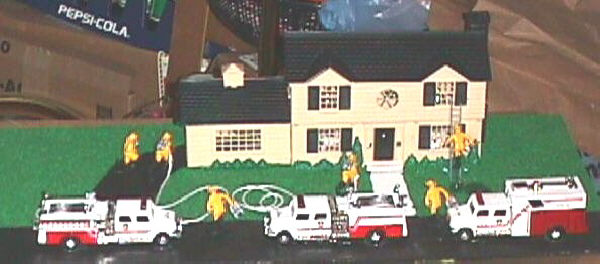


Creosote
|
The old adage "An Ounce of Prevention is Worth A Pound of Cure" is no more apropos than in the instance of
chimney fires. A regular cleaning and inspection of your stove and chimney can greatly reduce your chances of
having a chimney fire.
The more often you use the appliance, the more often it should be cleaned and inspected (at least once a year,
preferable more if you burn more than four ricks of wood) It is best to have a chimney sweep perform the task to be assured of a thorough cleaning.
CREOSOTE is the cause of most chimney fires. Creosote is a volatile byproduct resulting from the incomplete
combustion of wood. It accumulates in the stovepipe and chimney flue as a liquid, and later condenses into a solid.
Aside from blocking the flue (which reduces the stove's performance) a buildup of creosote is an accident waiting
to happen. It can ignite into a roaring chimney fire. The more creosote, the greater the chance of a fire.
There are basically three stages of creosote buildup. The first is a flaky, crystal-like accumulation. This can be
removed fairly easily with a chimney brush.
The second is a tar-like coating of creosote. This is harder to remove, but can be accomplished with a stiff
chimney brush and scraper.
The third (and most deadly) is a glossy, enamel-like coating on the flue, this is virtually impossible to remove.
Normally the best one can hope to do is scrape off the top layers, and reduce the buildup. There are some new
chemical cleaners which will remove this type of creosote, if professionally applied. Ask your chimney sweep
about this procedure. Don't be lulled into a false sense of security with over the counter
"chimney cleaners", I have yet to find them to work in the real world as claimed.
Creosote tends to accumulate in certain areas. In a fireplace installation check near the top of the firebox, in the
smoke chamber and around the damper. Any point where the stovepipe makes a bend is also a likely spot for the
buildup.
Check the flue, too. If you have an exterior chimney, the creosote will build up faster than if you have an interior
chimney because of the colder, outside temperature. While a chimney sweep can provide a valuable service in
keeping your chimney clean and safe, you as a homeowner can operate your stove in a manner that will minimize
creosote buildup.
BURN YOUR STOVE HOT: Sluggish fires create smoke, odor, air pollution and creosote. By maintaining a
small, hot fire with an open draft, more of the fuel will reach full combustion, reducing the amount of unburned
vapors escaping up the chimney. (It is these vapors that condense in the form of creosote).
BURN DRY WOOD: Wet wood reduces the burning temperature, adding to creosote buildup.
BE SAFE: Regularly check your stove and chimney for the first signs of creosote buildup.
Remember: An Ounce Of Prevention! We don't want to see the following at your house!!!
|

